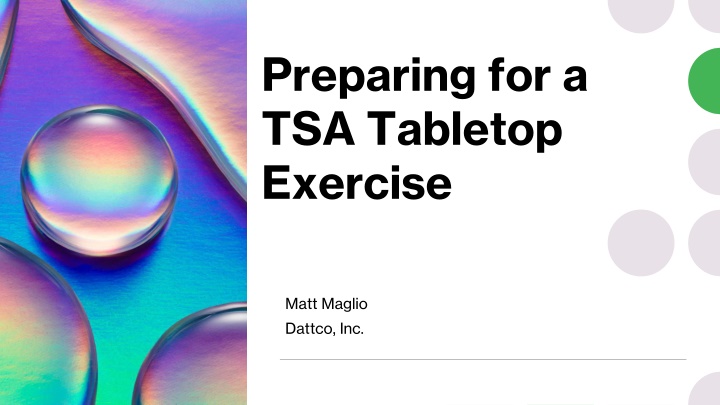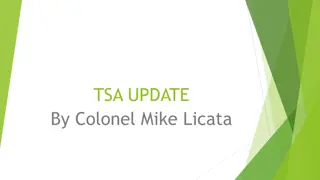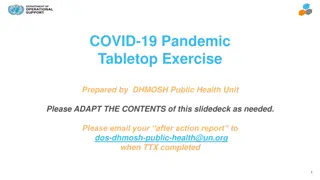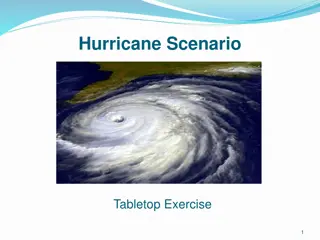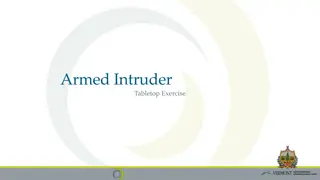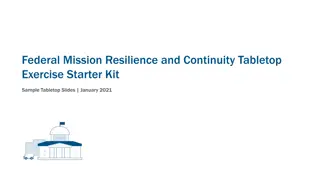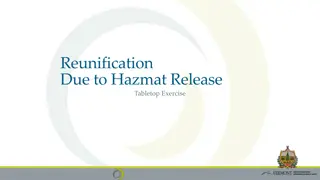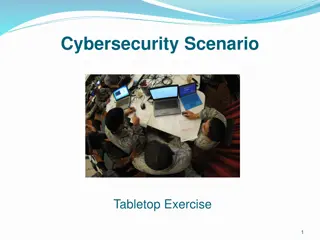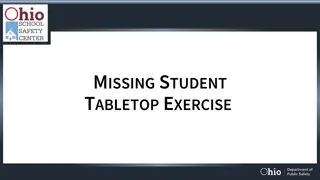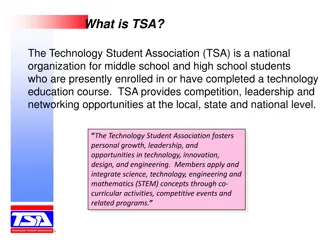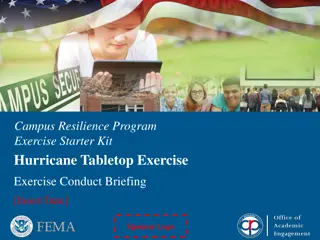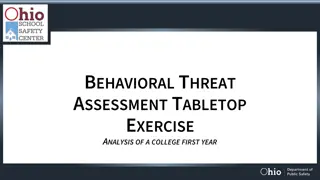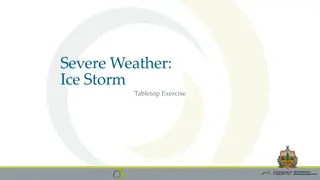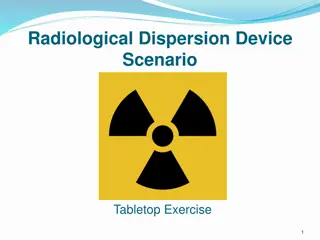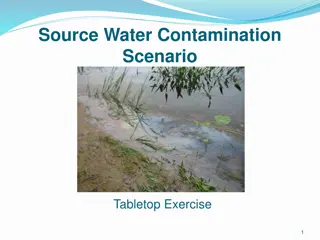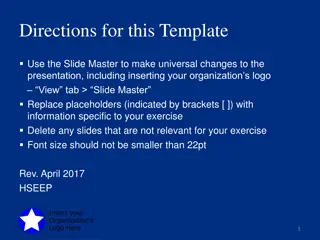TSA Tabletop Exercise Overview and Objectives
The Transportation Security Administration's (TSA) Intermodal Security Training and Exercise Program (I-STEP) provides exercise, training, and security planning tools and services to enhance security capabilities, build partnerships, and gain insights in transportation security. Learn about objectives during the exercise mission areas and scenarios to test transportation management plans effectively.
Download Presentation

Please find below an Image/Link to download the presentation.
The content on the website is provided AS IS for your information and personal use only. It may not be sold, licensed, or shared on other websites without obtaining consent from the author.If you encounter any issues during the download, it is possible that the publisher has removed the file from their server.
You are allowed to download the files provided on this website for personal or commercial use, subject to the condition that they are used lawfully. All files are the property of their respective owners.
The content on the website is provided AS IS for your information and personal use only. It may not be sold, licensed, or shared on other websites without obtaining consent from the author.
E N D
Presentation Transcript
Preparing for a TSA Tabletop Exercise Matt Maglio Dattco, Inc.
What is a TSA Table Top Excersice? Background The Transportation Security Administration's (TSA) Intermodal Security Training and Exercise Program (I-STEP) provides exercise, training, and security planning tools and services to the transportation community. The program focuses on the security nexus of the intermodal transportation environment, serving mass transit, freight rail, pipeline, port and intermodal, highway and motor carrier, and aviation modes. Working in partnership with the transportation modes, I-STEP enables security partners to: Enhance security capabilities - Strengthen plans, policies, and procedures; clarify roles and responsibilities; validate planning needs; and strengthen grant proposals. Build partnerships - Develop relationships with regional transportation players and other stakeholders. Gain insights in transportation security - Network with peers to gain a deeper understanding of security lessons learned and best practices. I-STEP is the only Federal exercise program to focus on the security nexus of the intermodal transportation environment. As a result, the program reduces risk to individual systems as well as the entire transportation network. I-STEP aligns to TSA's Transportation Systems Sector-Specific Plans (TSSSP) under the National Infrastructure Protection Plan (NIPP). The office of Policy, Plans, and Engagement (PPE) manages this program. The Exercise Information System (EXIS) portal guides users through a step-by-step exercise planning process to develop their own specific security exercise. EXIS is an intuitive system providing a variety of exercise planning and evaluation tools as well as lessons learned and best practices from the DHS Transportation Systems Sector and other aligned user communities. Lessons learned and best practices from exercises and training events along with intelligence information help shape transportation security policy and guidance. Go to: https://exis.tsa.dhs.gov to receive an account and use the tool.
Objectives During the Exercise Mission Area: Prevention Core Capability: Intelligence and Information Sharing Objective 1: Assess capabilities and coordination of participating organizations to support the collection, analysis, and dissemination of intelligence about security threats to national, regional, or local transportation operators and security stakeholders. Mission Area: Protection Core Capability: Physical Protective Measures Objective 2: Assess how transportation operators and security stakeholders select, resource, share, and implement risk-based physical protective measures following a security threat. Mission Area: Response Core Capability: Operational Coordination Objective 3: Assess capabilities of participating organizations to support local transportation operators, first responders, and other transportation security stakeholders coordinate and communicate following a coordinated attack.
Scenarios Scenarios The goal of testing a transportation management plan is not to be mistake free, but to identify potential problems areas. For tabletop exercises to be effective, they should test as many parts of the transportation management plan as possible using scenarios. A number of scenarios that cause disruptions to event traffic should be developed, keeping in mind that the scenarios should be as realistic as possible. Often times during a tabletop a simple scenario is presented to initiate discussion, and as the exercise progresses the scenario is escalated. During scenario discussions, operational problems and solutions can be identified. These scenarios typically do not require modeled network information, as their primary purpose is to test the stakeholders as to how they would react and to fine tune the responsibilities of each stakeholder and the communications protocol between the stakeholders.
Purpose The purpose of a tabletop exercise is to encourage discussion among the stakeholders and to develop recognition of coordination and planning requirements. This can only be accomplished if group discussion takes place freely and without embarrassment to any individual or service. In order to make sure this type of environment exists, it is critical that care be taken when identifying a facilitator for the tabletop exercise. The facilitator of the exercise should be someone who is knowledgeable with the planning and implementation of the transportation plans for planned special events but who is not an exercise "player." Ideally, this would either be the traffic engineer or an instructor who has the responsibility and knowledge of planned special events and resources available in your community. Planned special events tabletop exercise participants should (at least) include representatives of fire and rescue, police/law enforcement, transportation and/or public works, venue representatives, transit, emergency medical services, towing and recovery, elected officials, public information, and emergency management, and, if appropriate, a representative from the transportation operations center. Additional details concerning the roles and responsibilities of stakeholders typically involved with the traffic management for unplanned incidents is discussed in greater detail in the Roles and Responsibilities section. In addition, since participants can not be expected to remember all that takes place during the exercise, it is critical that observers be used to: (1) watch what happens, (2) take notes on what is seen and heard, and (3) recount observations during the review process.
Exercise Goal The goal of the event isn t to have a perfect error free exercise, but to identify weak areas that you can improve on for the future.
Organizations and Roles Transportation Transit Agency Police/Law Enforcement Emergency Medical Servies Emergency Management Towing and Recovery Venue Management
Organizations and Roles 2 Mayors Office/Governors Office Public Safety Communications Traffic Information/Media
Objectives 1. Alert Notification To demonstrate the ability to alert, mobilize, and activate the personnel, facilities, and systems required for emergence response, and provide for subsequent shift change staffing to maintain operations appropriate for the planned event. 2. Communications To determine the ability to establish and maintain communications essential to support the planned special event To demonstrate the ability to establish, use, maintain, and manage communications essential to support the planned event as well as any emergency or disaster response and recovery. 3. Coordination & Control To determine the coordination and the effectiveness of mutual aid plans among jurisdictions or organizations as part of the implementation of the planned special event. To determine the effectiveness of procedures for requesting resources from a higher level of government To determine the level of cooperation and coordination among and between agencies, departments, and organizations of the jurisdiction in responding to problems associated with a major planned event. To determine the ability of Transportation Management Center or Transportation Operations Center (TMC or TOC) personnel to assess events, make decisions on corrective action measures, and direct field personnel on procedures to remedy problems. To determine the level of knowledge that TMC or TOC personnel possess regarding plan familiarity, changes to the transportation plan, contingency planning, and decision-making. To determine the capabilities of the jurisdiction to effectively use support agencies when local forces are fully committed or incapable of providing a needed service To determine the adequacy of facilities, equipment, displays, and other materials to support the planned special event To determine the ability to assist activities through operations of an Incident Command System (ICS) To demonstrate the adequacy of facilities, equipment, displays, and associated materials to support direction and control of planned special events.
Roles and Responsibilities The roles and responsibilities or "back stories" for each of the groups represented in this guide is divided into two sections. The first group lists their planned special events responsibilities and the second section lists the responsibilities for unplanned events either traffic incidents or emergencies. Some of the groups that will participate in the tabletop have responsibilities for only one of these areas. Though the summary of the roles and responsibilities is somewhat generic, the write-up is intended to give the group as much information as possible about their responsibilities for both the planned events and unplanned incidents/emergencies. Planned Special Events The oversight team involves stakeholders participating in program planning activities to improve the management of travel during future planned special events. These stakeholders include mid-to-upper level representatives of transportation agencies and law enforcement. Additional stakeholders include elected officials, regional organizations, and other government agencies. Members of an oversight team work to establish policies, regulations, procedures, and task forces for future application to a specific planned special event. Team members may work with an event planning team, consult on feasibility study results and evaluate conceptual transportation management plan components. Stakeholders may also work independent of the team to evaluate potential new technology applications that may improve their performance and capabilities while meeting team objectives.
Objectives 4. Public Information To determine the capability of the public information system to provide official information and instruction to diverse populations in order to facilitate timely and appropriate public response during a planned special event To demonstrate the capability to coordinate the formulation and dissemination of clear, accurate, and consistent information to the public and news media, and to control the spread of rumors that could impact on the public safety. 5. Health & Medical To determine the ability to protect emergency responder health and safety To determine the adequacy of personnel, procedures, equipment, and vehicles for transporting injured individuals, and the adequacy of medical personnel and facilities to support the operation. To demonstrate the capability to mobilize and employ health and medical resources and mitigate public health problems during a major planned event that could result in an emergency or mass disaster situation. To demonstrate the capability to identify and mobilize resources and organize the delivery of crisis assistance and other human services in response to a major emergency or disaster.
Objectives 6. Public Safety/Transportation To direct traffic. To facilitate the safe and efficient flow of traffic through traffic control and enforcement. To develop and execute a street traffic management plan. To manage traffic control and security on the day-of-event To enforce traffic and parking restrictions To escort dignitaries to/from the event venue To enforce the requirements of a traffic operations agency To manage transportation operations on streets adjacent to the venue and/or corridors serving the venue during planned special events. For those local and county law enforcement agencies with a traffic operations bureau or for the local and/or state departments of transportation, to be responsible for developing and executing a local street traffic management plan. To approve local street closures. To approve an event traffic flow plan. Approve temporary traffic control deployment. To determine the effectiveness of search and rescue procedures during a planned special event, major emergency or disaster To employ good traffic incident procedures to ensure both the safety of the responder and to ensure the safe movement of traffic
Objectives 7. Public Works To determine the adequacy of procedures for providing to field forces such support services as food and refreshments, apparatus and equipment maintenance, sanitary facilities, and medical care. 8. Resource Management To determine the thoroughness, usefulness, understandability, and accuracy of the transportation management plan and other key references. To determine the effectiveness of procedures for deployment of emergency personnel and equipment during a planned special event To determine adequacy of procedures for replacement of fatigued personnel during a planned special event. To determine if a system has been developed for recruiting, training, and using volunteers during a planned special event. To determine the capabilities of agencies, departments, and organizations of the jurisdiction for the effective handling of the attendees to a planned special event To determine the ability of public officials to conduct their duties in accordance with standard operating procedures (SOP's), the emergency operations plan (EOP), and state statutes. To demonstrate the ability to locate, mobilize, and manage (including allocation and prioritization) personnel, equipment, supplies, facilities, and services as part of a planned special event.
Objectives 9. Warning To demonstrate the capability to promptly alert and notify the public of imminent disaster or hazardous conditions and to disseminate instructional messages to the public on the basis of authority from, or decisions by, appropriate State and local officials. 10.Effectiveness of Warning To determine the adequacy of equipment and procedures for alerting and warning the population during a planned special event in the event of a major emergency or disaster 11.Other Non-Emergencies Objectives To determine if officials have coordinated utility disaster plans with the local emergency operations plan. To determine the capabilities of the jurisdiction to handle routine/normal incidents in addition to responding to events associated with a major emergency or disaster. To determine the ability to document response to an incident/accident NOTE: It is recommended that no more that 6 8 or so objectives are chosen for any one exercise.
After Action Review After action reviews are conducted after a tabletop or any exercise has ended. The purpose of the review is to: Evaluate changes and corrections to the planned special events transportation plan. Evaluate what if any additional interagency coordination is needed. Serve as a guide for future exercises. Verify the exercise goals were achieved. Evaluate training and staff deficiencies. Participant input is also crucial in the review process. They can note difficulties experienced during the exercise that might not be obvious to observers. Reviewers should debrief participants as soon as possible after the exercise so participants do not forget what they experienced. These participant observations should also be included in a more extensive review of the exercise. Individuals who do not represent day-of event traffic management team personnel or event stakeholders can be very useful in moderating the review process since they do not bring real or perceived bias into the process. Finally, all of the observations and insights are useless unless there exists some opportunity to incorporate recommended changes into the transportation management plan.
Preparing Identify the stakeholders who will participate in the exercise. Distribute copies of the transportation management plan and implementation plan to participants. Develop a script for the exercise, including surprise elements, which may not be addressed in the transportation management plan. Provide a timeline for the exercise to play-out (the exercise will probably take place in an accelerated timeframe compared to a real-life event). Identify reviewers who will watch the exercise and take notes. Provide time to review the exercise. Modify the plan based on what was learned during the exercise.
Policies, Procedures Do you have an active shooter policy? Do you have a process for an unidentified item on a bus? Do you do any awareness training? Who should a driver call first? Fight or Flight Response on a Motor Coach, School Bus, Transit Bus?
How to make this a success The following are guidelines that will make your tabletop exercise more effective: The exercise should be held in a room with a conference table, or with the seating arranged in a manner in which the participants are able to see all other participants. Have coffee/soda available for the participants helps promote a relaxed atmosphere. Provide a large detailed map of the exercise area so that all participants can visualize the area involved. A recorder (not an exercise "player") should write down exercise responses and note the major issues/problems. Plan on at least one hour, preferably three for the exercise. If the exercise fails to become productive within the first hour, it's best to discontinue and discuss the possible reasons why this has occurred. After the exercise-all participants should be asked to complete an evaluation of the exercise, and make suggestions and comments with regard to emergency operations plan revisions. A need to schedule future meetings to revise the plan shortly after this tabletop exercise, while thoughts are still fresh in everyone's mind, may be appropriate. Additional tabletop exercises may be needed to evaluate the revisions/accomplish local goals of this exercise.
